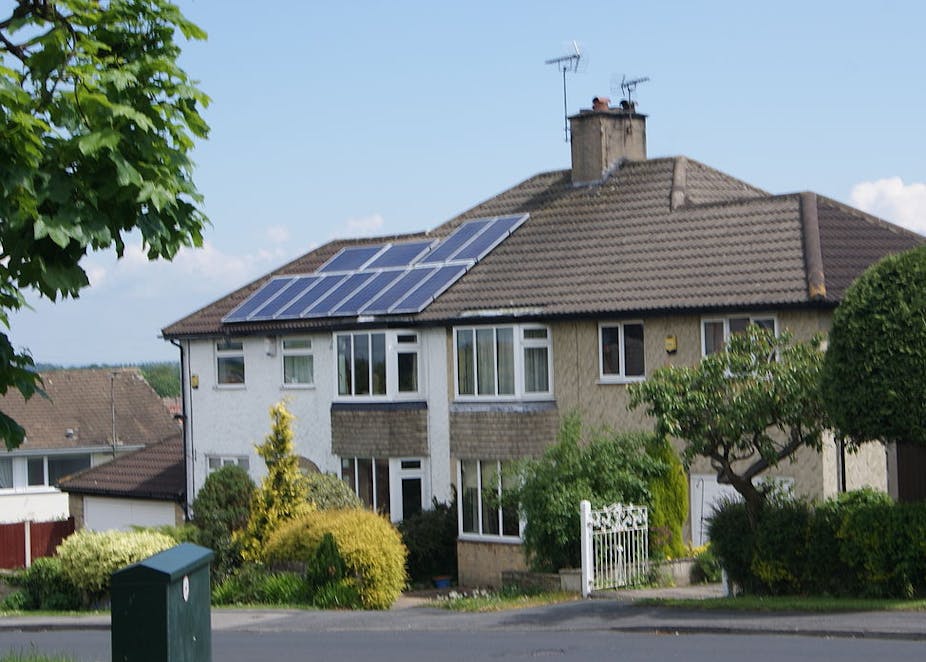Energy-generating solar panels provide the opportunity to generate low-carbon electricity from the roof over your head, at a cost that has fallen dramatically and continues to slide.
So many governments worldwide have promoted the technology through policies such as net metering, feed-in tariffs and subsidies which have helped the use of solar energy to blossom over the past five years.
However, rooftop solar panels, or photovoltaics (PV), require a large, unshaded, south-facing roof to generate maximum returns in Britain and similar countries in the northern hemisphere. As these are all things associated with a premium quality property, some have argued that solar energy subsidies simply provide already wealthy homeowners with a means to reduce their bills and generate income by selling energy back to the grid, at the expense of poorer households in rented flats next door.
A solar photovoltaic system can cost upwards of £6,000 but can earn the homeowner around £750 per year for the next 20 years in savings on energy bills and payments from incentives.
This is particularly pertinent in the UK where subsidy payments, known as the feed-in tariff which ensures a good economic return for PV installations and is responsible for driving the growth of Britain’s PV industry, are paid through a levy on all consumers’ bills. When feed-in tariffs were introduced in 2010, it was envisioned this would lead to the annual household energy bill rising by £8 (where the average household bill is around £1,300 per year). So is this a government regressive tax? Not necessarily.
Solar power for all
Various ways of taking advantage of solar power have arisen in the years since. Those with money but without a roof of their own can invest in solar power companies to reap the benefits. Community energy co-operatives such as Brixton Energy pool people’s cash in order to install solar panels on community roofs such as schools or sports centres, or local charities, providing each with extra income. The Solar Schools project for example asks local communities to donate toward installing PVs on school roofs, in order to provide a steady income for the school for the next 20 years.
Crowdfunding has been the latest trend in clean energy investment and a number of ventures have used this method of raising seed capital in the UK and abroad. Through firms such as Abundance Generation anyone can invest as little as £5 into a renewable energy project, taking advantage of the high rates of return that renewable projects currently offer.

For those with a roof but no money, sourcing finance for renewable energy projects has become easier. Even Ikea has started offering PV systems and the finance packages to afford them. Alternatively, companies such as ISIS Solar offer the equipment for free, lowering the homeowners’ bills and taking the feed-in tariff payments in return.
This has tempted the likes of housing associations and local authorities, as they can greatly reduce their tenants’ bills while also hitting their carbon emission reduction targets – without any up-front investment on their part.
But what about those who live in a private rented flat and have no roof to offer nor money to invest? This is where the real value of distributed energy comes in, because through community energy co-operatives the benefits from distributed electricity generation can be shared. Brixton Energy, for example, adds a fraction of the profits from their rooftop solar projects to a community fund to pay for energy efficiency measures, advice and workshops to tackle fuel poverty and boost the cash-saving possibilities for the entire community.
Benefits beyond the rooftop
A greater adoption of solar power brings other benefits beyond clean electricity. A study by the Buildings Research Establishment found that the solar power industry in the UK employed 14,000 people in 2013. You could call that the equivalent of 20 jobs per megawatt of installed rooftop solar power capacity.
Another study that examined the case in the US found that PV systems employ more than double the number of people per megawatt of electricity generated than any other source of renewable energy – and far more than any fossil fuel. Because these jobs are also distributed among communities, the workers’ earnings are ploughed back into several local economies rather than into a single town which might be, for example, the site of a large power plant.
The cash saved by lowering electricity bills and earned from the feed-in tariff is also more likely to be spent within the local economy. By comparison, the profits of large multinational energy companies may be taken out of town or indeed entirely overseas by foreign shareholders.
So a subsidy for solar power doesn’t have to be a subsidy for the rich. Rooftop solar can help grow local economies, provide local jobs and increase local spending. At the same time it can provide a bulwark against energy poverty through the work of community energy co-operatives and installations that provide power to social housing. Photovoltaics are nothing less than a democratising force on the energy supply system – but this requires people, communities and companies to act together to make the most of it.

